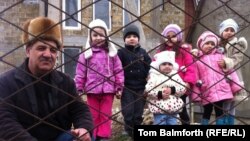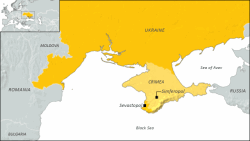FONTANY 5, UKRAINE —
At first glance, the village of Fontany 5 exudes a sleepy suburban calm.
But below the surface of this Crimean Tatar settlement of about 500 people, there is fear.
Russian troops are stationed just a few kilometers away on the streets of the Crimean capital, Simferopol. And rumors are in the air of looming attacks against Tatars.
Mudasir Kafodar, a 55-year-old ethnic Tatar, holds his young granddaughter in the garden of his two-story stone house as his other six grandchildren played nearby.
“We want to live in peace. But Russian troops have entered our territory - Ukrainian territory - and armed men are walking around. It scares us - not just me, but all of us,” Kafodar says.
“They don’t say anything. They don’t explain who they are. But it’s clear they’re not Ukrainian - they’re Russian.”
Kafodar was born in Uzbekistan and in 2000 moved back to Crimea, which he considers his homeland. His parents - now 93 and 85 - were deported by Stalin in 1944. He has built his own family's ancestral home from scratch and now fears losing it.
Tatars make up roughly 12 percent of Crimea's two million inhabitants. Most were deported to Soviet Central Asia by Josef Stalin during World War II, accused of collaborating with the Nazis, and only returned after Ukraine won its independence in 1991.
And unlike the vast majority of Crimean residents, most Tatars supported the Euromaidan protests in Kyiv that toppled the pro-Moscow regime of ousted president Viktor Yanukovych. They also are strong supporters of Ukrainian independence, of Crimea remaining in Ukraine, and of Kyiv’s drive for European integration.
And with the Russian troops now in the picture, many fear Crimea could fall under Moscow's sway.
But for Tatars like Kafodar the Russian military is not the only fear.
Rumors of attacks
For the more than two decades since Ukrainian independence, Crimean Tatars have lived together uneasily on the peninsula with ethnic Russians, who make up roughly 60 percent of the population and who yearn for Crimea to be part of Russia.
Kafodar says rumors of attacks against Tatars in nearby villages, rumors that RFE/RL has been unable to independently confirm, are raising alarm bells.
“What can we do? We are a peaceful people. We are not preparing for anything. What can we do?” Kafodar asks.
“Several nights ago...unidentified men went to the house of Crimean Tatars and beat up the father and son. They are in the hospital. Now they say unidentified men are going to attack [settlements like ours].”
With Cossacks and other pro-Moscow groups marching through the streets of Simferopol chanting "Russia! Russia!" Kafodar and other villagers are taking measures - albeit modest - to defend themselves. Every evening, he says, about 20 residents of Fontany 5 keep a look out.
Kafodar says they do not carry weapons and hope to appeal to would-be assailants that they are peaceful.
“We are Crimean Tatars. We live here. We don’t need this [military action and unrest]. But we are a peaceful people. We are not planning anything bad. We aren’t even saying a word.”
In the Crimean capital, Simferopol, meanwhile, Tatar civic leaders were nervous but defiant. The Crimean Tatar Assembly, or Medjlis, was buzzing with activity on March 1 as groups of men nervously discussed the unfolding situation.
Ali Khamzii, a representative of the Medjlis, says “it seems like [Russian President Vladimir] Putin has given the order to occupy Crimea.”
“And he will send forces to the east as well. I can say only one thing. I am not going to flee. This is not Ukrainian land, it’s not Russian land; this is Crimean Tatar land.”
But below the surface of this Crimean Tatar settlement of about 500 people, there is fear.
Russian troops are stationed just a few kilometers away on the streets of the Crimean capital, Simferopol. And rumors are in the air of looming attacks against Tatars.
Mudasir Kafodar, a 55-year-old ethnic Tatar, holds his young granddaughter in the garden of his two-story stone house as his other six grandchildren played nearby.
“We want to live in peace. But Russian troops have entered our territory - Ukrainian territory - and armed men are walking around. It scares us - not just me, but all of us,” Kafodar says.
“They don’t say anything. They don’t explain who they are. But it’s clear they’re not Ukrainian - they’re Russian.”
Kafodar was born in Uzbekistan and in 2000 moved back to Crimea, which he considers his homeland. His parents - now 93 and 85 - were deported by Stalin in 1944. He has built his own family's ancestral home from scratch and now fears losing it.
Tatars make up roughly 12 percent of Crimea's two million inhabitants. Most were deported to Soviet Central Asia by Josef Stalin during World War II, accused of collaborating with the Nazis, and only returned after Ukraine won its independence in 1991.
And unlike the vast majority of Crimean residents, most Tatars supported the Euromaidan protests in Kyiv that toppled the pro-Moscow regime of ousted president Viktor Yanukovych. They also are strong supporters of Ukrainian independence, of Crimea remaining in Ukraine, and of Kyiv’s drive for European integration.
And with the Russian troops now in the picture, many fear Crimea could fall under Moscow's sway.
But for Tatars like Kafodar the Russian military is not the only fear.
Rumors of attacks
For the more than two decades since Ukrainian independence, Crimean Tatars have lived together uneasily on the peninsula with ethnic Russians, who make up roughly 60 percent of the population and who yearn for Crimea to be part of Russia.
Kafodar says rumors of attacks against Tatars in nearby villages, rumors that RFE/RL has been unable to independently confirm, are raising alarm bells.
“What can we do? We are a peaceful people. We are not preparing for anything. What can we do?” Kafodar asks.
“Several nights ago...unidentified men went to the house of Crimean Tatars and beat up the father and son. They are in the hospital. Now they say unidentified men are going to attack [settlements like ours].”
With Cossacks and other pro-Moscow groups marching through the streets of Simferopol chanting "Russia! Russia!" Kafodar and other villagers are taking measures - albeit modest - to defend themselves. Every evening, he says, about 20 residents of Fontany 5 keep a look out.
Kafodar says they do not carry weapons and hope to appeal to would-be assailants that they are peaceful.
“We are Crimean Tatars. We live here. We don’t need this [military action and unrest]. But we are a peaceful people. We are not planning anything bad. We aren’t even saying a word.”
In the Crimean capital, Simferopol, meanwhile, Tatar civic leaders were nervous but defiant. The Crimean Tatar Assembly, or Medjlis, was buzzing with activity on March 1 as groups of men nervously discussed the unfolding situation.
Ali Khamzii, a representative of the Medjlis, says “it seems like [Russian President Vladimir] Putin has given the order to occupy Crimea.”
“And he will send forces to the east as well. I can say only one thing. I am not going to flee. This is not Ukrainian land, it’s not Russian land; this is Crimean Tatar land.”









